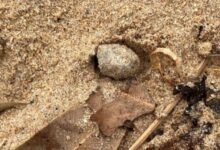Djibouti’s hidden rock art offers window to the past

SMA NEWS – ABOURMA
From a distance, the black cliffs appear featureless, scorched by a blazing desert sun. But up close, the basalt reveals engravings of giraffe, ostrich and antelope made 7,000 years ago.
These masterful works, etched onto stone in northern Djibouti, are among the most important examples of rock art in the Horn of Africa, a region rich in archaeological heritage and the birthplace of humanity.
Stretching three kilometers (almost two miles), some 900 panels at Abourma depict in wonderful relief prehistoric life in these parts, dramatic scenes of early man confronting wildlife, and droving cows.
But these centuries-old images, rendered by flint onto igneous rock, also offer a valuable record of a bygone era — and a land drastically reshaped by millennia of climate change.
The wildlife illustrated are still found today on Africa’s plains and grasslands, but not in Djibouti, a harsh desert landscape where water and greenery have been scarce for thousands of years.
“Today, Abourma is something of a cemetery because we don’t have these animals here anymore. At the time, they roamed here because Djibouti was covered in forest,” said Omar Mohamed Kamil, a young tour guide who takes visitors to Abourma.
“In Abourma… we are a little removed from civilization. We are in the prehistory, we are living in prehistory.”
This treasure trove lies a six-hour drive away from the capital, Djibouti City, then a further one hour on foot over a craggy expanse of boulders.
It would be all-but impossible to find were it not for Ibrahim Dabale Loubak, a camel breeder and Abourma’s custodian, who claims to “know every stone, every nook and cranny” of this rocky massif.








